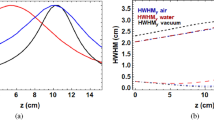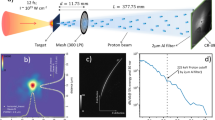Abstract
High-energy proton microbeam facilities are powerful tools in space science, biology and cancer therapy studies. The primary limitations of the 50 MeV proton microbeam system are the poor beam quality provided by the cyclotron and the problem of intense scattering in the slit position. Here, we present an optical design for a cyclotron-based 50 MeV high-energy proton microbeam system with a micron-sized resolution. The microbeam system, which has an Oxford triplet lens configuration, has relatively small spherical aberrations and is insensitive to changes in the beam divergence angle and momentum spread. In addition, the energy filtration included in the system can reduce the beam momentum spread from 1 to 0.02%. The effects of lens parasitic aberrations and the lens fringe field on the beam spot resolution are also discussed. In addition, owing to the severe scattering of 50 MeV protons in slit materials, a slit system model based on the Geant4 toolkit enables the quantitative analysis of scattered protons and secondary particles. For the slit system settings under a 10-micron final beam spot, very few scattered protons can enter the quadrupole lens system and affect the focusing performance of the microbeam system, but the secondary radiation of neutrons and gamma rays generated at the collimation system should be considered for the 50 MeV proton microbeam. These data demonstrate that a 50 MeV proton microbeam system with a micron-sized beam spot based on a cyclotron is feasible.










Similar content being viewed by others
Data availability
The data that support the findings of this study are openly available in Science Data Bank at https://doi.org/10.57760/sciencedb.j00186.00078 and https://cstr.cn/31253.11.sciencedb.j00186.00078
References
J.C. Chancellor, G.B. Scott, J.P. Sutton, Space radiation: the number one risk to astronaut health beyond low earth orbit. Life (Basel). 4, 491–510 (2014). https://doi.org/10.3390/life4030491
A. Kronenberg, F.A. Cucinotta, Space radiation protection issues. Health Phys. 103, 556–567 (2012). https://doi.org/10.1097/HP.0b013e3182690caf
G.D. Badhwar, P.M. O’Neill, Long-term modulation of galactic cosmic radiation and its model for space exploration. Adv. Space Res. 14, 749–757 (1994). https://doi.org/10.1016/0273-1177(94)90537-1
F.A. Cucinotta, H. Nikjoo, D.T. Goodhead, The effects of delta rays on the number of particle-track traversals per cell in laboratory and space exposures. Radiat. Res. 150, 115–119 (1998). https://doi.org/10.2307/3579651
L.W. Townsend, F.A. Cucinotta, J.W. Wilson et al., Estimates of HZE particle contributions to SPE radiation exposures on interplanetary missions. Adv. Space Res. 14, 671–674 (1994). https://doi.org/10.1016/0273-1177(94)90524-X
J.A. Cookson, F.D. Pilling, The use of focused ion beams for analysis. Thin Solid Films 19, 381–385 (1973). https://doi.org/10.1016/0040-6090(73)90074-6
J.A. van Kan, A.A. Bettiol, F. Watt, Three-dimensional nanolithography using proton beam writing. Appl. Phys. Lett. 83, 1629–1631 (2003). https://doi.org/10.1063/1.1604468
F. Watt, M.B.H. Breese, A.A. Bettiol et al., Proton beam writing. Mater. Today. 10, 20–29 (2007). https://doi.org/10.1016/S1369-7021(07)70129-3
P. Barberet, H. Seznec, Advances in microbeam technologies and applications to radiation biology. Radiat. Prot. Dosim. 166, 182–187 (2015). https://doi.org/10.1093/rpd/ncv192
K.-D. Greif, H.J. Brede, D. Frankenberg et al., The PTB single ion microbeam for irradiation of living cells. Nucl. Instrum. Methods B 217, 505–512 (2004). https://doi.org/10.1016/j.nimb.2003.11.082
C. Siebenwirth, C. Greubel, S.E. Drexler et al., Determination of the accuracy for targeted irradiations of cellular substructures at SNAKE. Nucl. Instrum. Methods B 348, 137–142 (2015). https://doi.org/10.1016/j.nimb.2015.01.064
G.H. Du, J.L. Guo, R.Q. Wu et al., The first interdisciplinary experiments at the IMP high energy microbeam. Nucl. Instrum. Methods B 348, 18–22 (2015). https://doi.org/10.1016/j.nimb.2015.01.066
C. Greubel, W. Assmann, C. Burgdorf et al., Scanning irradiation device for mice in vivo with pulsed and continuous proton beams. Radiat. Environ. Biophys. 50, 339–344 (2011). https://doi.org/10.1007/s00411-011-0365-x
W. Lijun, W. Shaohu, Y. Zengliang, T.K. Hei, G. Rander-Pehrson, Columbia University microbeam: development of an experimental system for targeting cells individually with counted particles. Nucl. Sci. Tech. 10, 143–148 (1999)
F. Watt, X. Chen, C.B. Chen et al., Whole cell structural imaging at 20 nanometre resolutions using MeV ions. Nucl. Instrum. Methods B 306, 6–11 (2013). https://doi.org/10.1016/j.nimb.2012.11.047
W.-T. Yang, X.-C. Du, Y.-H. Li et al., Single-event-effect propagation investigation on nanoscale system on chip by applying heavy-ion microbeam and event tree analysis. Nucl. Sci. Tech. 32, 106 (2021). https://doi.org/10.1007/s41365-021-00943-6
Y.-Q. Yang, W.-C. Fang, X.-X. Huang et al., Static superconducting gantry-based proton CT combined with X-ray CT as prior image for FLASH proton therapy. Nucl. Sci. Tech. 34, 11 (2023). https://doi.org/10.1007/s41365-022-01163-2
H. Zhang, J.-Z. Li, R. Hou et al., Design and development of an ACCT for the Shanghai advanced proton therapy facility. Nucl. Sci. Tech. 33, 126 (2022). https://doi.org/10.1007/s41365-022-01106-x
X.-S. Sun, Y.-J. Li, J.-Y. Liu et al., Shortening the delivery time of proton therapy by real-time compensation method with raster scanning. Nucl. Sci. Tech. 33, 73 (2022). https://doi.org/10.1007/s41365-022-01051-9
B. Qin, X. Liu, Q.-S. Chen et al., Design and development of the beamline for a proton therapy system. Nucl Sci Tech. 32, 138 (2021). https://doi.org/10.1007/s41365-021-00975-y
C.G. Ren, S.J. Zhou, J.M. Che et al., A microbeam system of high energy ions at Fudan university. Nucl. Sci. Tech. 2, 13–18 (1991)
G. Datzmann, G. Dollinger, G. Hinderer et al., A superconducting multipole lens for focusing high energy ions. Nucl. Instrum. Methods B 158, 74–80 (1999). https://doi.org/10.1016/S0168-583X(99)00308-0
J.S.C. Mckee, G.R. Smith, Y.H. Yeo et al., The manitoba automated high-energy proton microprobe (MA-HEM) and its application to research in the geological and biological sciences. Nucl. Instrum. Methods B 40, 680–684 (1989). https://doi.org/10.1016/0168-583X(89)91074-4
L.N. Sheng, M.T. Song, X.Q. Zhang et al., Design of the IMP microbeam irradiation system for 100 MeV/u heavy ions. Chin. Phys. C 33, 315 (2009). https://doi.org/10.1088/1674-1137/33/4/016
A. Ponomarov, G.H. Du, J.L. Guo et al., Beam optics of upgraded high energy heavy ion microbeam in Lanzhou. Nucl. Instrum. Methods B 461, 10–15 (2019). https://doi.org/10.1016/j.nimb.2019.09.002
T. Vallentin, M. Moser, S. Eschbaumer et al., A microbeam slit system for high beam currents. Nucl. Instrum. Methods B 348, 43–47 (2015). https://doi.org/10.1016/j.nimb.2014.12.015
M. Oikawa, T. Kamiya, M. Fukuda et al., Design of a focusing high-energy heavy ion microbeam system at the JAERI AVF cyclotron. Nucl. Instrum. Methods B 210, 54–58 (2003). https://doi.org/10.1016/S0168-583X(03)01007-3
F. Watt, G.W. Grime, G.D. Blower et al., The Oxford 1 μm proton microprobe. Nucl. Instrum. Methods 197, 65–77 (1982). https://doi.org/10.1016/0167-5087(82)90119-3
G.W. Grime, WinTRAX: A raytracing software package for the design of multipole focusing systems. Nucl. Instrum. Methods B 306, 76–80 (2013). https://doi.org/10.1016/j.nimb.2012.11.038
F. Méot, The ray-tracing code Zgoubi. Nucl. Instrum. Methods A 427, 353–356 (1999). https://doi.org/10.1016/S0168-9002(98)01508-3
F. Méot, The ray-tracing code Zgoubi–Status. Nucl. Instrum. Methods A 767, 112–125 (2014). https://doi.org/10.1016/j.nima.2014.07.022
M.B.H. Breese, D.N. Jamieson, P.J.C. King, Material analysis using a nuclear microprobe. J. Microsc-Oxford. 189, 99–100 (1996). https://doi.org/10.1046/j.1365-2818.1998.0270c.x
C.G. Ryan, PIXE and the nuclear microprobe: tools for quantitative imaging of complex natural materials. Nucl. Instrum. Methods B 269, 2151–2162 (2011). https://doi.org/10.1016/j.nimb.2011.02.046
V. Brazhnik, A. Dymnikov, R. Hellborg et al., The effect of lens arrangement in a triplet and in a Russian quadruplet on the demagnification and beam current in a microprobe. Nucl. Instrum. Methods B 77, 29–34 (1993). https://doi.org/10.1016/0168-583X(93)95518-A
Y.X. Dou, D.N. Jamieson, J.L. Liu et al., GEANT4 models for the secondary radiation flux in the collimation system of a 300MeV proton microbeam. Phys. Med. 32, 1841–1845 (2016). https://doi.org/10.1016/j.ejmp.2016.10.008
G.W. Grime, F. Watt, G.D. Blower et al., Real and parasitic aberrations of quadrupole probe-forming systems. Nucl. Instrum. Methods. 197, 97–109 (1982). https://doi.org/10.1016/0167-5087(82)90123-5
S. Incerti, P. Barberet, R. Villeneuve et al., Simulation of cellular irradiation with the CENBG microbeam line using GEANT4. IEEE Trans. Nucl. Sci. 51, 1395–1401 (2004). https://doi.org/10.1109/TNS.2004.832224
L.N. Sheng, M.T. Song, X.Q. Zhang et al., High energy heavy ion microbeam irradiation facility at IMP. Nucl. Instrum. Methods B 269, 2189–2192 (2011). https://doi.org/10.1016/j.nimb.2011.02.075
G.H. Du, Techniques and multi-disciplinary applications of ion microbeam. Nucl. Phys. Rev. 29, 371 (2012). https://doi.org/10.11804/NuclPhysRev.29.04.371
J.F. Ziegler, M.D. Ziegler, J.P. Biersack, SRIM—the stopping and range of ions in matter (2010). Nucl. Instrum. Methods B 268, 1818–1823 (2010). https://doi.org/10.1016/j.nimb.2010.02.091
S. Agostinelli, J. Allison, K. Amako et al., Geant4—a simulation toolkit. Nucl. Instrum. Methods A 506, 250–303 (2003). https://doi.org/10.1016/S0168-9002(03)01368-8
Acknowledgements
The authors acknowledge G.W. Grime (University of Surrey) for technical communication and for providing the computer software WinTRAX, and François Méot (Brookhaven National Laboratory) and D. N. Jamieson (The University of Melbourne) for providing the computer software Zgoubi and PRAM, respectively.
Author information
Authors and Affiliations
Contributions
All authors contributed to the study conception and design. Material preparation, data collection and analysis were performed by Hong-Jin Mou, Guang-Bo Mao and Guang-Hua Du. The first draft of the manuscript was written by Hong-Jin Mou and all authors commented on previous versions of the manuscript. All authors read and approved the final manuscript.
Corresponding author
Ethics declarations
Conflict of interest
The authors declare that they have no competing interests.
Additional information
This work was supported by the National Natural Science Foundation of China (Nos. 1197283 and U1632271) and the National Key R&D Program of China (No. 2021YFA1601400).
Rights and permissions
Springer Nature or its licensor (e.g. a society or other partner) holds exclusive rights to this article under a publishing agreement with the author(s) or other rightsholder(s); author self-archiving of the accepted manuscript version of this article is solely governed by the terms of such publishing agreement and applicable law.
About this article
Cite this article
Mou, HJ., Mao, GB., Zhang, JQ. et al. Design of 50 MeV proton microbeam based on cyclotron accelerator. NUCL SCI TECH 34, 92 (2023). https://doi.org/10.1007/s41365-023-01235-x
Received:
Revised:
Accepted:
Published:
DOI: https://doi.org/10.1007/s41365-023-01235-x




